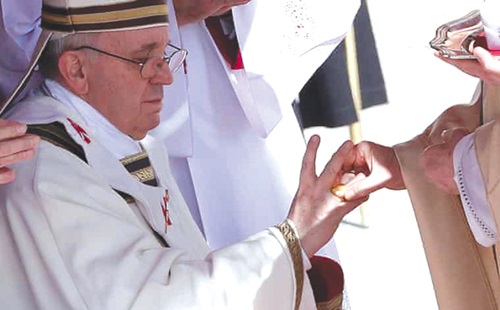Modesty in true modesty, the mortal remains of Pope Francis will be interred in the Santa Maria La Major Basilica in Rome in Italy after the 88-year-old yielded to death on Monday, April 21, 2025.
The head of the Catholic Church, a global icon revered for his modesty and service to mankind, Pope Francis will attract the world’s biggest political figures to his funeral Mass and burial in the Italian capital, with millions across the world beyond the Catholic faithful waiting to pay their last respects.
Catholic insiders revealed upon his death that the Pope had chosen the modest place for his final resting place instead of the more lavish surroundings of the Vatican where his predecessors lay.
"I ask that my tomb be prepared in the niche of the side nave between the Pauline Chapel (Chapel of the Salus Populi Romani) and the Sforza Chapel of the Basilica of St Mary Major.
The tomb must be in the earth; simple, without particular decoration and with the only inscription: ‘Francis’,” the Pope’s Spiritual Testament read.
It is the ultimate description of the values he upheld on earth, a life that sacrificed comfort and luxury for modesty, and ignored fortune for the cross and crown that Christians pursue on earth.
Various accounts suggest Pope Francis had a net worth of $100 at the time of his death, a remarkably modest value for a man whose occupation could have earned him up to €340,000 a year.
Instead, he declined living on a salary of the Vatican, as he made a vow of poverty, which guided his lifestyle choices, and lived with justice.
His life and his net worth were in sharp contrast to the Vatican's estimated assets of between $10 billion and $15 billion and considered generally to reflect his preference for simplicity and service.
He also lived in a modest Vatican guesthouse instead of the traditional papal apartments.
As one of the main candidates for the papacy when Pope John Paul II died, then Cardinal Jorge Mario Bergoglio eventually succeeded Pope Benedict XVI as Pope Francis.
Pope Francis had battled serious pneumonia in the month before his passing, his lungs barely sustaining his fragile life in an advanced age.
Indeed, he had defied death to the cheers of the world as he soldiered on against serious odds beyond the 12th anniversary of his climb to the papacy on March 13, 2025.
His death united the world in mournful convergence, with world leaders paying glowing tributes to his selfless service to humanity.
It could not have been worse when on Easter Sunday, the memoriam of Christ's resurrection from the dead, he presided over a Mass only to pass the next morning.
Global appeal
Such is his appeal that the National Chief Imam, Sheikh Dr Osman Nuhu Sharubutu, has extended condolences to the leadership of the Catholic Church in Ghana and the Vatican as they mourn the late pontiff.
![]()
Pope Francis in coffin at The Vatican for the key ceremony
In a statement issued on his behalf by his Personal Assistant, Dr Mohammed Marzuq Abubakari Azindoo, Sheikh Sharubutu said the passing of the pontiff was a great loss to the global interfaith community, particularly the Abrahamic fraternity.
“And the world would, forever, remember an icon whose voice helped shape international order in many areas of life: from moral leadership to human rights championship,” the Chief Imam said.
He said throughout the late Pope’s papacy, “Pope Francis stood for the marginalised.
It was, therefore, not surprising that on the eve of his departure to eternity, he called for an end to the atrocities in Gaza”.
Growing up
Pope Francis was born Jorge Mario Bergoglio on December 17, 1936, in Buenos Aires in Argentina to an Italian immigrant family.
He is said to have had part of a lung removed due to a respiratory infection when he was a teenager.
Before becoming a priest, Pope Francis worked odd jobs, including being a bouncer at a nightclub and a janitor.
He is the first Pope from the Jesuit Order, a Catholic religious society focused on missionary work, education and theological scholarship.
Legacies
Pope Francis is credited with the introduction several significant changes to the papal funeral rites by approving a new edition of the liturgical book that governs the burial of a Roman Pontiff (Ordo Exsequiarum Romani Pontificis).
These revisions, as narrated by Most Rev. Joseph Osei-Bonsu, Emeritus Bishop of Konongo-Mampong, reflected his longstanding commitment to simplicity, humility and a more pastoral image of the papacy.
These changes, he said, included eliminating the use of multiple coffins, and by extension the traditional skull and crossbones engraving.
Under the new rites, the Pope is buried in a single wooden coffin lined with zinc, without the ornate symbols previously used.
Therefore, the skull and crossbones are no longer used in papal funerals, marking a departure from centuries-old traditions in favour of a more modest approach.
Other elements in the revised version, Most Rev. Osei-Bonsu said, included how the Pope’s mortal remains were to be handled after death.
The ascertainment of death takes place in the chapel, rather than in the room where he died, and his body is immediately placed inside the coffin.
According to Archbishop Diego Ravelli, Master of Apostolic Ceremonies, the late Pope Francis had requested that the funeral rites be simplified and focused on expressing the faith of the Church in the Risen Body of Christ.
“The renewed rite seeks to emphasise even more that the funeral of the Roman Pontiff is that of a pastor and disciple of Christ, and not of a powerful person of this world,” Archbishop Ravelli is reported to have said.

